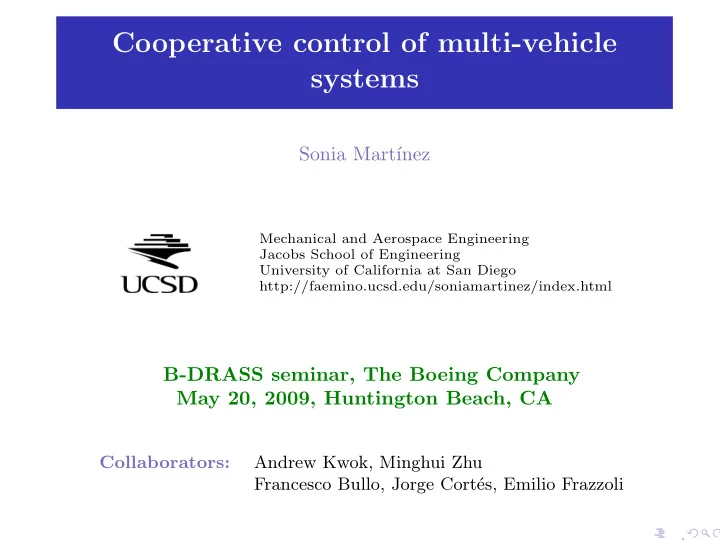

Cooperative control of multi-vehicle systems Sonia Mart´ ınez Mechanical and Aerospace Engineering Jacobs School of Engineering University of California at San Diego http://faemino.ucsd.edu/soniamartinez/index.html B-DRASS seminar, The Boeing Company May 20, 2009, Huntington Beach, CA Collaborators: Andrew Kwok, Minghui Zhu Francesco Bullo, Jorge Cort´ es, Emilio Frazzoli ,
Multi-agent networks What kind of systems? Groups of agents with control, sensing, communication and computing Each individual senses its immediate environment communicates with others processes information gathered takes local action in response ,
Self-organized behaviors in biological groups Natural multi-agent systems: ,
Decision making in animals Able to deploy over a given region assume specified pattern rendezvous at a common point jointly initiate motion/change direction in a synchronized way Species achieve synchronized behavior with limited sensing/communication between individuals without apparently following group leader (Couzin et al, Nature 05; Conradt et al, Nature 03) ,
������ � ����������� ���������� ������������ ������������� ������ �� ���� ������������ ������������ ������� ��� ������������������������������������������������������� ����������� ������� �������������������� �������������������������� ������������������ ���������������������������������������������� ����������������������������������������� ������������ � ����������������������� ������������������������� ��������� Emerging technologies and multi-agent systems Distributed habitat/environment monitoring systems Great Duck Island Scripps multi-UAV project, UCSD ASAP project illustration Disaster relief operations, rapid deployment systems, surveillance Health monitoring in smart bridges, buildings, roads 25 Motes on Damaged sidewall Wind Response Soil monitoring Of Golden Gate Bridge surveillance Berkeley motes Sandia National Labs Berkeley ,
Research challenges What useful engineering tasks can be performed with limited-sensing/communication agents? Dynamics simple interactions give rise to rich emerging behavior Feedback rather than open-loop computation for known/static setup Information flow who knows what, when, why, how, dynamically changing Reliability/performance robust, efficient, predictable behavior How to coordinate individual agents into coherent whole? Objective: systematic methodologies to design and analyze cooperative strategies to control multi-agent systems ,
� ����������� ����������� ���������� ������������ ������������� ������ �� ���� ������������ ������������ ������ ������� ������� ��� ������������������������������������������������������� �������������������� �������������������������� ������������������ ���������������������������������������������� ����������������������������������������� ������������ � ����������������������� ������������������������� ��������� Research program: What are we after? Development of system-theoretic tools to analyze general coordination algorithms under disturbances Synthesis of distributed motion coordination algorithms that are flexible, reconfigurable, scalable and verifiably correct Synthesis of distributed filters and learning algorithms to allow for distributed and adaptive decision making Testbed development for technology transition ,
Text: Distributed Control of Robotic Networks 1 intro to distributed algorithms (graph theory, synchronous networks, and averaging algos) 2 geometric models and geometric optimization problems 3 model for robotic, relative sensing networks, and complexity 4 algorithms for rendezvous, deployment, boundary estimation Status: Freely downloadable at http://coordinationbook.info with tutorial slides & software libraries. Shortly on sale by Princeton Univ Press ,
Outline 1 Motivation 2 Sample motion coordination algorithms and results Multi-vehicle Deployment & Task Assignment Multi-vehicle Rendezvous Motion coordination for optimal estimation 3 Conclusions and Future Work ,
Deployment algorithms Goal: Given n agents in an environment Q , achieve optimal coverage by designing ˙ p i = u i , i ∈ { 1 , . . . , n } Metrics capturing “good deployment” Area jointly covered — limited sensing ranges Expected network cost to visit locations in Q : constrained dynamics (motion constraints, environmental flows) limited energy budget for each agent to move Local Rules can be synthesized that are: 1 locally efficient, distributed, lead to stable emerging behaviors 2 robust to failures and asynchronous computations ,
Rendezvous algorithms Goal: Given nodes ( p 1 , . . . , p n ) moving in environment Q , gather at a given location of Q Metrics capturing “rendezvous” objective Disagreement in position Diameter of network Local Rules can be synthesized that: 1 Achieve task under switching connectivity conditions 2 Totally distributed 3 Work under rather persistent communication/sensing failures 4 Are robust to measurement noise and asynchronous behavior ,
Motion coordination for optimal estimation Goal 1: Track a moving target q 0 Goal 2: Track an evolving boundary Information metrics Fisher Information metrics Goodness-of-interpolation metrics Local Rules can be synthesized that are: 1 Distributed, able to track a global/local maxima (bounded error depending on the velocity of change) 2 Robust to communication/sensing failures 3 Robust to asynchronous behaviors ,
Sample simulations ,
Summary Basic motion coordination algorithms for multiagent systems sample primitives: deployment, rendezvous, optimal estimation System-theoretic tools for design: proximity graphs, graph theory distributed algorithms set-valued maps, invariance principles . . . Features of algorithms: scalable, adaptive, verifiably correct, robust, distributed ,
Current and Future work Energy-efficient coordination algorithms Motion coordination partially known, time-varying environments Distributed optimization and learning for multi-agent systems Selfish and cooperative multi-agent behaviors Distributed receding-horizon control policies Coordination of multiple vehicles under communication limitations Adversarial multi-robot teams ,
Thank you! ,
Recommend
More recommend